
Vanilla Walnut Rolls
These walnut rolls are the ultimate cinnamon rolls for people who don’t like cinnamon. My new and improved brioche dough gets rolled with sweetened tiny ground walnuts and vanilla beans. Top with a dusting of powdered sugar and serve with your morning coffee!

Why you’ll love these walnut rolls
- The dough is SO SOFT and pillowy.
- Since there’s no frosting, they feel so much lighter.
- The walnuts are ground small so they don’t take away from the pillowy dough.
- The walnuts really balance well with the sugar, making them less sweet and more balanced.
If you’re a cinnamon roll fanatic like me, some of my other favorites are s’mores cinnamon rolls, chocolate cinnamon rolls, caramelized white chocolate rolls and lemon brown butter rolls.
If you’re lookin for something to make on Christmas morning, I’ll have a gingerbread cinnamon roll and a cranberry orange cinnamon roll posted in the next couple weeks too!
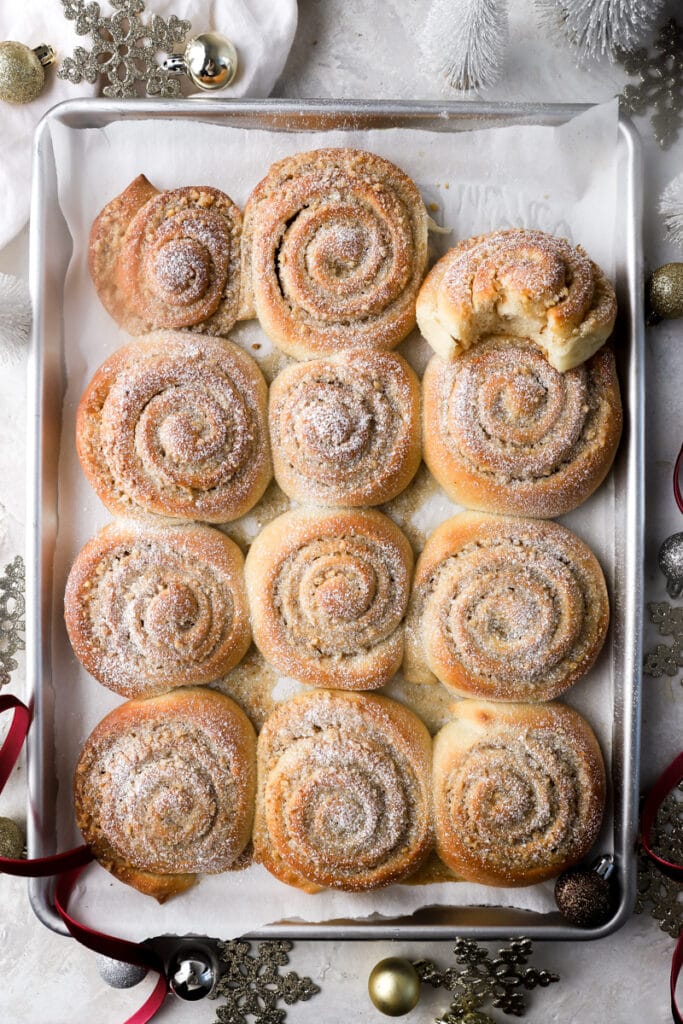
Ingredients & Substitutions
- Flour: I’ve made this dough with both bread flour and all purpose flour with no noticeable difference in the dough.
- I HIGHLY recommend using a digital scale, as flour is so often over measured.
- Yeast: I used one package of active dry yeast. That can also be subbed with instant yeast, just skip the activation step and mix it in with the rest of the ingredients. I still do both proofs with instant yeast, it’s just usually much quicker (about half the time).
- If you store your yeast in a jar instead of individual packages you can use a scant tablespoon of yeast. Also make sure to store the yeast in the fridge if it’s an open jar.
- Sugar: I used a little bit of granulated sugar in the dough. I also opted for granulated sugar for the filling so that it doesn’t taste as similar to a cinnamon roll and allows the walnuts to shine a bit more.
- Brown sugar also works for the filling if you do want it more like a traditional cinnamon roll.
- Water: this may seem weird since most people make brioche with milk. I have tested cinnamon rolls and brioche donuts several times both with milk and water and I found that water makes a much softer dough.
- Butter: I like to use salted butter but you can also use unsalted butter as well. Dairy free butter also works well.
- Eggs: make sure to use one room temperature large egg.
- Pop it in hot water for a few minutes if it’s cold.
- Walnuts: To be honest, you can use any kind of nut you want here. I went with walnuts because it reminds of traditional Hungarian walnut rolls and this is what my mom asked for lol.
- Vanilla: when I’m making a “vanilla” dessert, I like to use the good stuff. I had some vanilla powder that I made by grinding some dried vanilla pods. You can also buy vanilla powder or use vanilla beans from inside a pod. For the filling, I mix the vanilla powder with the walnuts and sugar since it’s dry.
- Vanilla extract or vanilla bean paste will also work but I would use about 1 tsp for the dough and 1 tsp for the filling. For the filling, mix the vanilla with the butter if you’re using extract or paste.
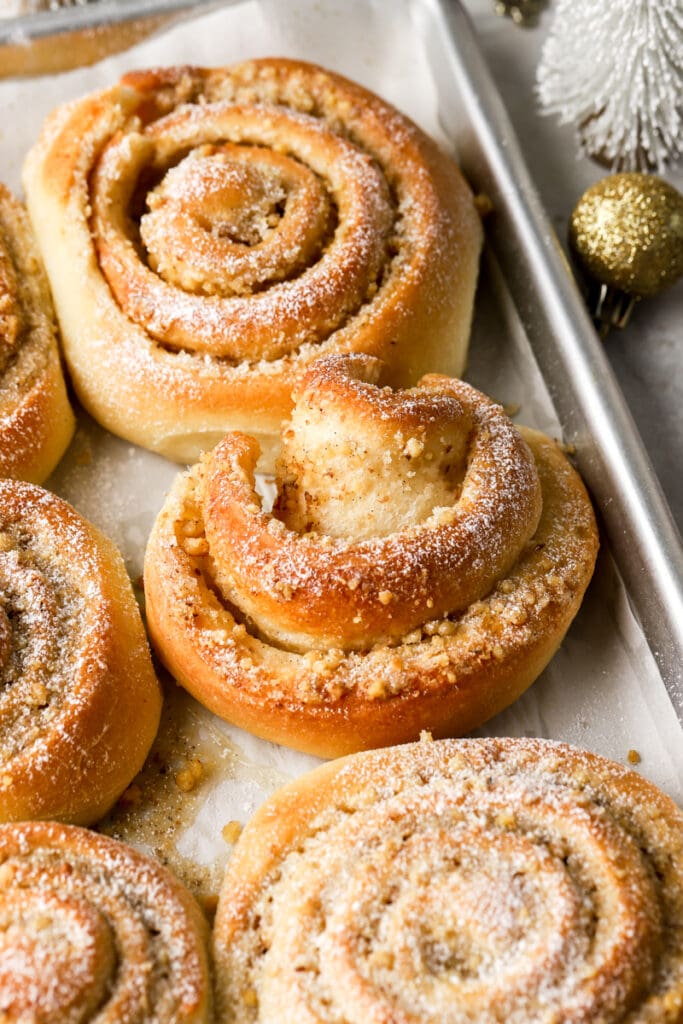
Step-by-Step Instructions
Step 1: Start by making the brioche by activating the yeast with the sugar in warm water for a few minutes. Once the yeast starts to foam a little, add the melted butter and egg, mixing until they’re somewhat combined. Then add the flour mix until it comes together. Knead for 5-10 minutes in the bowl of the stand mixer with the hook attachment (or 10-15 minutes by hand).
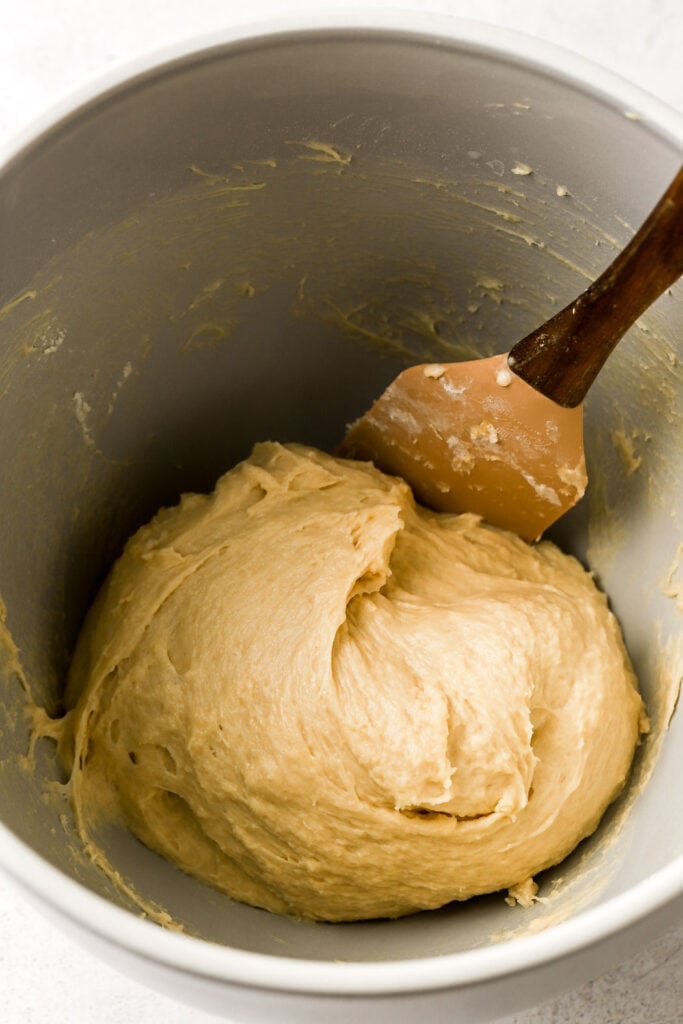
Step 2: Cover and let it proof for about 60-90 minutes in a warm environment, until it’s doubled in size and fluffy.
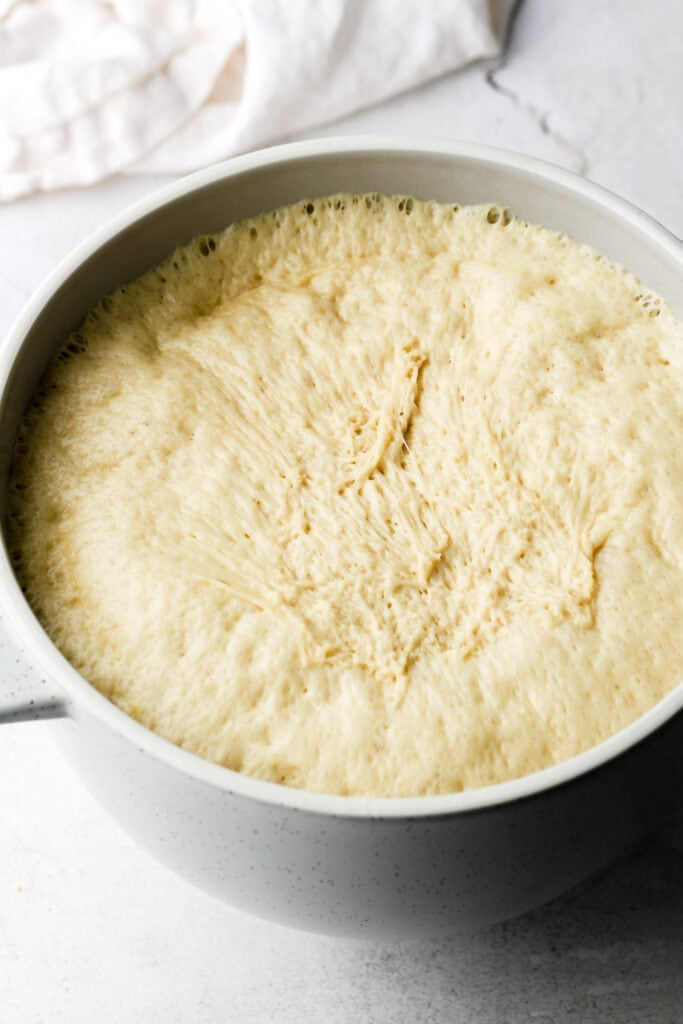
Step 3: Make the filling by placing the walnuts in a food processor and pulsing until they’re ground. Mix with the sugar and vanilla beans/powder and aside.

Step 4: Shape the dough by punching down the air and placing it onto a floured surface. Stretch it out into a rectangle the best you can with your hands and then use a rolling pin to roll it out to about a 12×16 inch rectangle.

Step 5: Add the filling by spreading the butter evenly on top of the dough. Then sprinkle the walnut sugar mixture on top of the butter, spreading it out evenly.
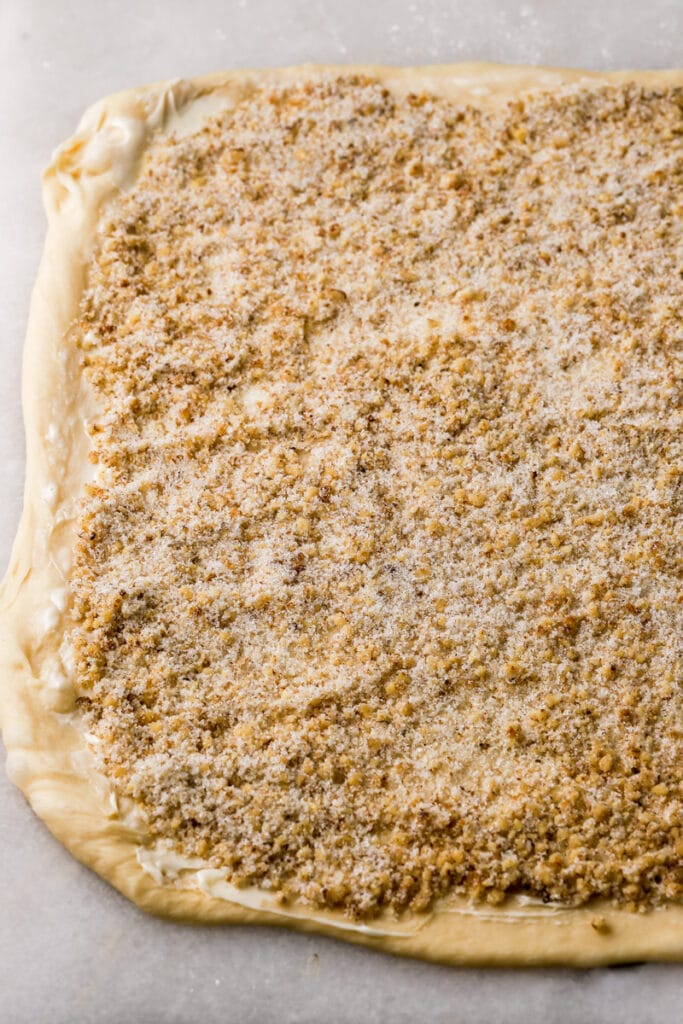
Step 6: Roll the dough into a tight log, starting at one of the short ends, so you have a shorter fat log, not a long skinny roll. Use a large serrated knife to slice into 12 rolls.
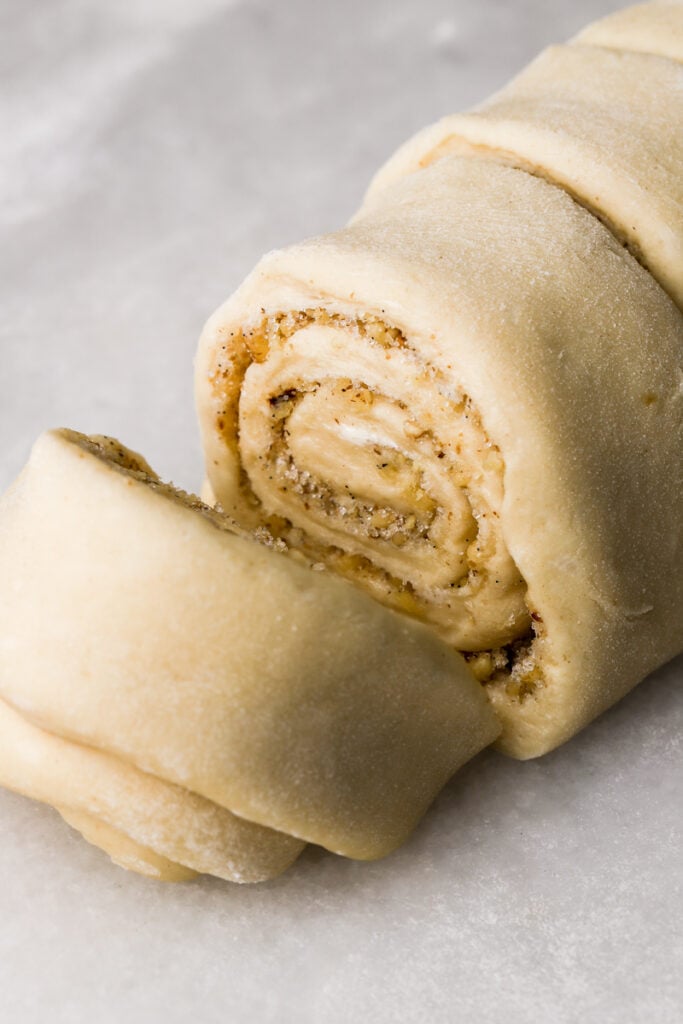
Step 7: Place into the prepared pan, cover and allow to proof in a warm environment for another 30-45 minutes, until doubled in size.
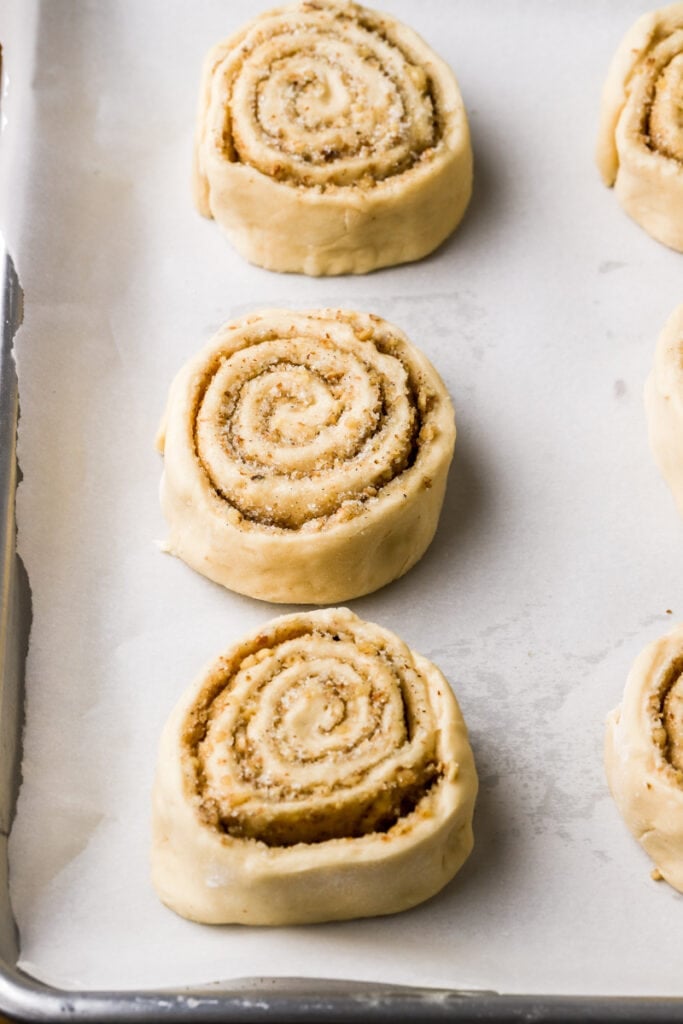
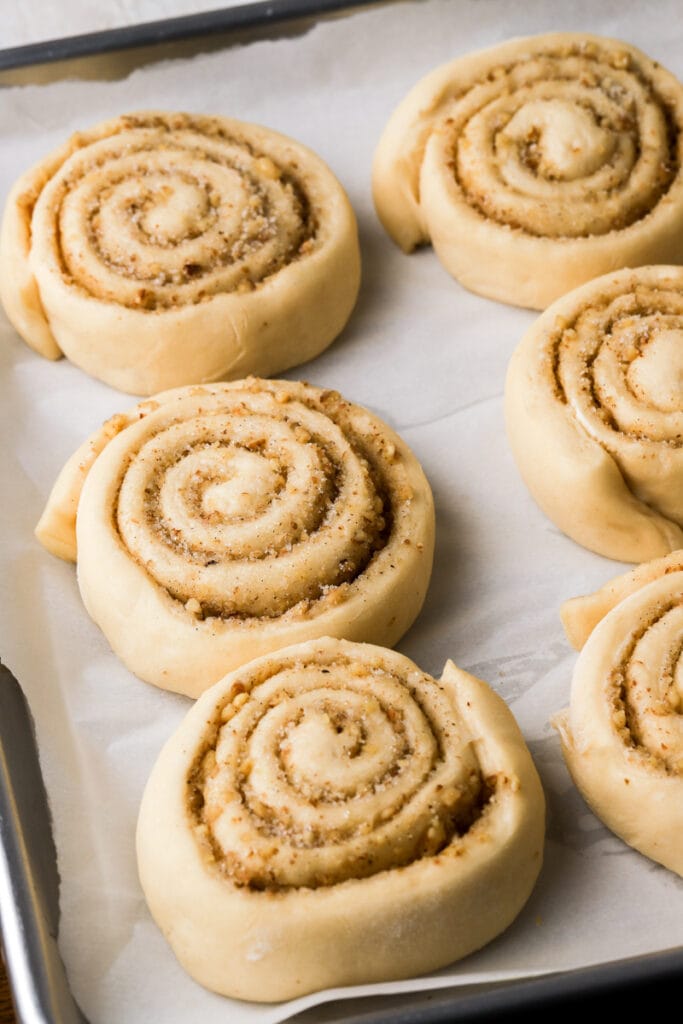
Step 8: Bake for about 20-25 minutes until the bread is golden brown. I like to use a butter knife to push one of the rolls away from the other ones so I can see the bottom edge. It should be super soft, pale but baked and not raw or doughy.
Step 9: Allow the rolls to cool for a few minutes. Dust with powdered sugar and serve warm or at room temperature.
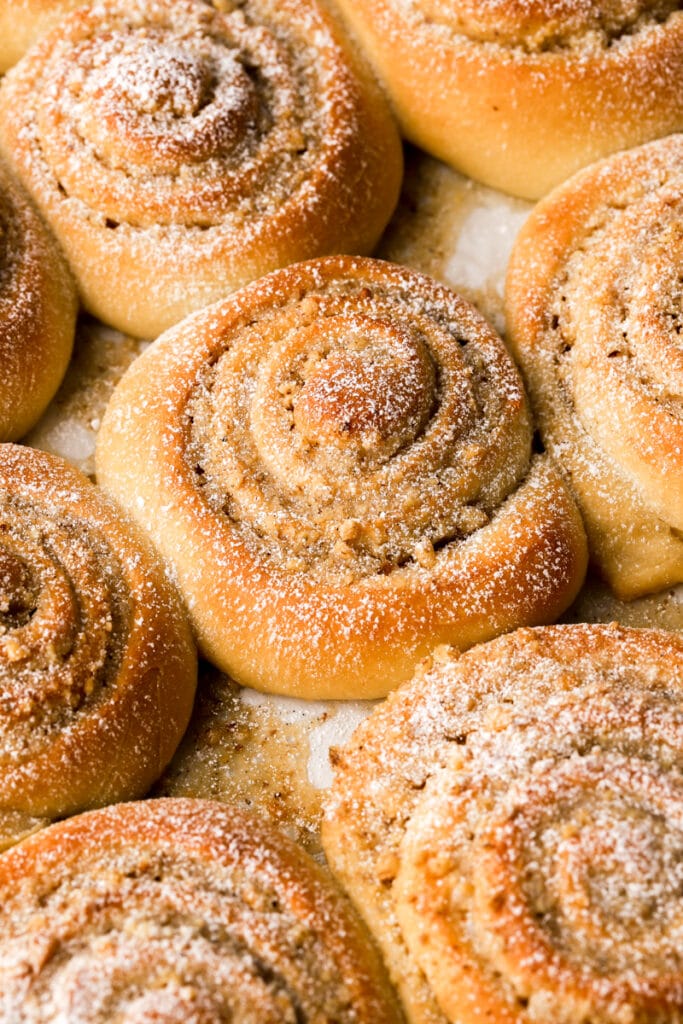
How to know when the dough is done kneading?
For this brioche dough, I know it’s done kneading when the dough is strong enough to stick to itself and peel away from the edge of the bowl. You’ll see it progress to this and form a ball around the hook attachment.
If it’s not making progress within the first five minutes of kneading and the dough is really sticky, add in 2 more tablespoons (15g) of flour and continue kneading.
What temperature to proof dough at?
You want to make sure your dough is proofing at a comfortable temperature. Generally, room temperature is fine but if it’s slightly warmer, you’ll get a much quicker rise.
Yeast dies at around 120F (50C) so make sure the temperature is lower than that. I recommend anywhere between 75F (24C) to 100F (38C).
The dough can also be proofed in the refrigerator. This is called a retarding proof because it really slows down the process. The Benefit of this is that you can just pop the dough in the fridge overnight and the dough will develop a stronger flavor if it proofs for longer.
You can refrigerate the dough overnight for the first proof or the second proof, just bring it back to room temperature before proceeding with the recipe.
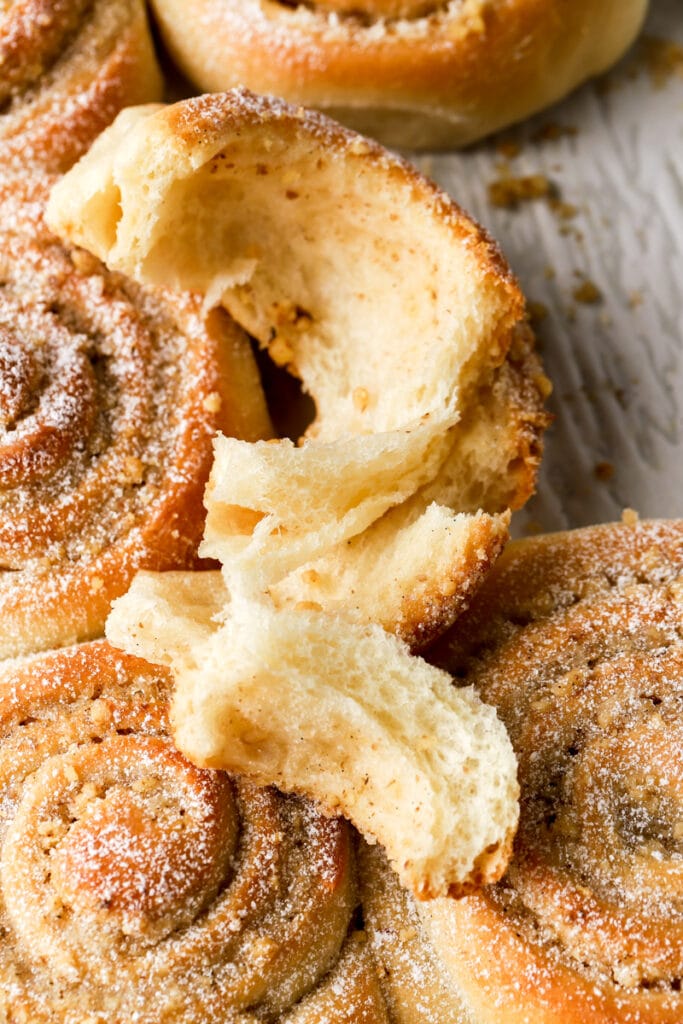
How to know when dough is done rising/proofing
Rising and proofing are typically used interchangeably but the initial ‘resting time’ is actually the rising and the second ‘resting time’ is the proofing. The time needed for rising/proofing is dependent on the recipe and the environment.
Typically with instant yeast, you’re “allowed” to skip the first rise and just let the dough relax for just 10 minutes instead before shaping the dough. I prefer to still let it rise, it just requires less time with instant yeast. It works both ways but I get a fluffier dough from letting it proof twice.
A general guideline is that the dough should double in size each time. It should also slowly spring back when you press on it, but also leave a small indent.
If the dough springs back quickly, then it needs more time to rise. If it doesn’t spring back at all, it may be over slightly over-proofed but should still be ok. If the dough has begun shrinking before you touch it, it may well over-proofed and result in a flat bread.
How to make rolls overnight
Brioche can easily be prepped the night before and baked in the morning. After the dough is rolled and sliced and placed in the prepared pan, cover it tightly with plastic wrap and place it in the fridge overnight. Remove the rolls from the fridge about 45 minutes before baking them. Bake them per the instructions.
How to store walnut rolls
There’s NOTHING like a warm roll straight from the oven but if they’re not served immediately, simply place them in an airtight container and store at room temperature for 1-2 days.
If it’s longer, refrigerate them for up to a week. When serving, reheat them in the microwave for a few seconds or the oven just until they’re warm.
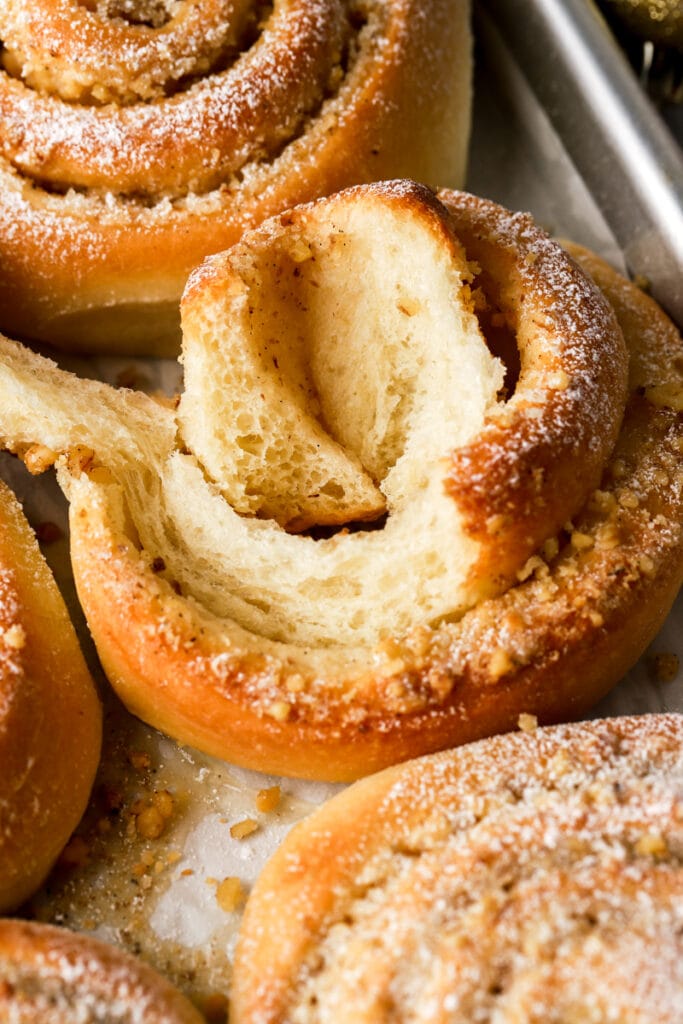
Frequently Asked Questions
You can use dairy free butter for the dough and the filling.
I have not tested any bread recipes with gluten-free flours but if you do try, please let us know in the comment section 🙂
I like to use a 9×13 inch pan (or just slightly larger) if I’m making 12 rolls. The one pictured is larger, that works as well but they will spread more, making them shorter and requiring a few minutes less in the oven.
To use a 12 inch cast iron pan, slice the log into 9 larger rolls instead of 12 and place one roll in the center. Then place 8 around the center one and bake for about 27 minutes.
You can use any type of nut for the filling. You can use white or brown sugar and add any spices.
I was pretty tempted to later on some cream cheese frosting here as well so if you’re feeling that, try the frosting from my classic cinnamon rolls or this gorgeous vanilla bean cream cheese frosting.
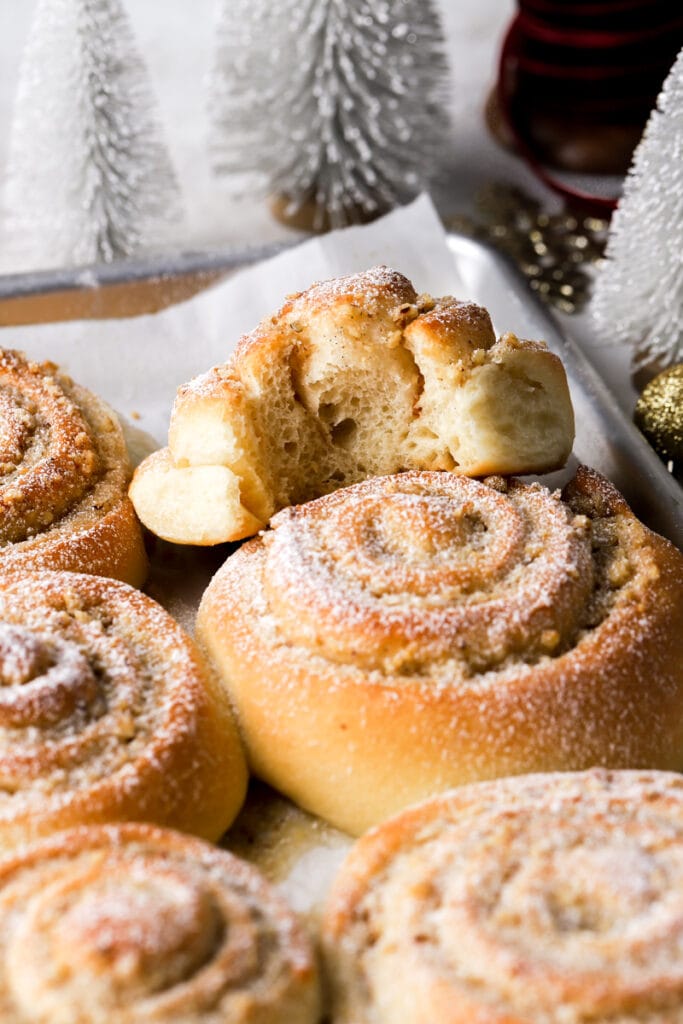
Thanks so much for reading today’s post, if you have any questions just comment down below. Make sure to leave it in the comment section because I can’t answer in the rating section.
If you make these fabulous vanilla walnut rolls, I’d love it if you left a star rating for me. If it’s less than five stars, please leave a comment with the rating so I know why! 🙂
As always, have a blessed day and happy baking!
Love, B
Vanilla Walnut Roll Recipe
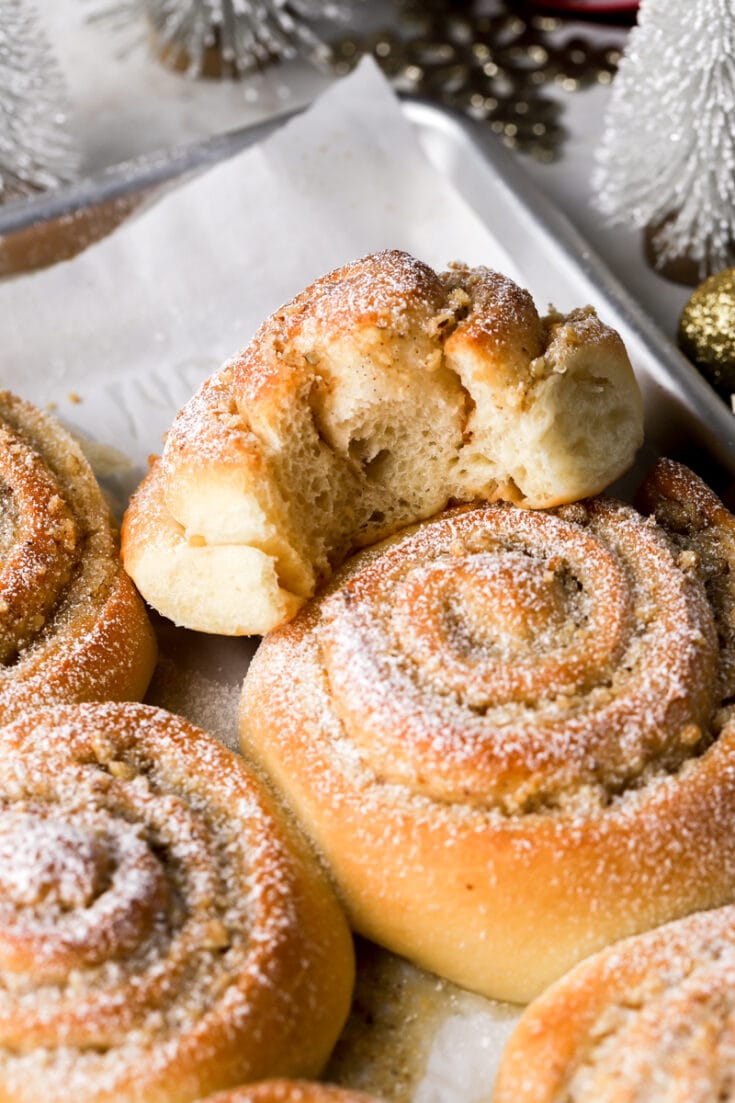
These walnut rolls are the ultimate cinnamon roll for people who don’t like cinnamon. My new and improved brioche dough gets rolled with sweetened tiny ground walnuts and vanilla beans. Top with a dusting of powdered sugar and serve with your morning coffee!
Ingredients
Dough
- 1 cup (240mL) warm water
- 1/4 cup (50g) granulated sugar
- 7g (1 packet) active dry yeast
- 1/2 cup (113g) salted butter, melted
- 1 large egg
- 1/4 tsp vanilla powder/beans (or 1 tsp vanilla bean paste/extract)
- 3 1/2 cups (420g) bread flour (or all-purpose flour), spooned and leveled
- 1 tsp fine sea salt
Filling
- 1/4 cup (56g) salted butter, softened
- 1 cup (112g) walnuts, ground
- 1/2 cup (100g) granulated sugar
- 1/4 tsp vanilla beans/powder OR 1 tsp vanilla bean paste or extract
Instructions
Dough
- Place the yeast with half of the sugar and the warm water in the bowl of a stand mixer. Mix and allow it to rest for 5-10 minutes, until the yeast starts to foam.
- Add the rest of the sugar, melted butter, egg and vanilla, mixing until they’re somewhat combined. Then add the flour and salt and mix until it comes together.
- Use the hook attachment to knead the dough for 5-10 minutes (10-15 minutes by hand), until the dough feels itself away from the edge of the bowl.
- Cover and let it proof for about 60-90 minutes in a warm environment (75-100F/24-38C), until it’s doubled in size and fluffy.
Filling
- Make the filling by placing the walnuts in a food processor and pulsing until they’re ground. Mix with the sugar and vanilla beans/powder and aside.
Shape
- Grease a 9x13x2 inch pan with butter, oil or baking spray (I use the wrapper of the butter and just wipe it around the pan).
- Shape the dough by punching down the air and placing it onto a floured surface. Stretch it out into a rectangle the best you can with your hands and then use a rolling pin to roll it out to about a 12x16 inch rectangle.
- Add the filling by spreading the butter evenly on top of the dough. Then sprinkle the walnut sugar mixture on top of the butter, spreading it out evenly.
- Roll the dough into a tight log, starting at one of the short ends, so you have a shorter fat log, not a long skinny roll. Use a large serrated knife to slice into 12 rolls. Place into the prepared pan, cover and allow to proof in a warm environment for another 30-45 minutes, until doubled in size.
- Preheat the oven to 3350F/177C convection (325F/163C conventional).
- Bake for about 20-25 minutes until the bread is golden brown. I like to use a butter knife to push one of the rolls away from the other ones so I can see the bottom edge. It should be super soft, pale but baked and not raw or doughy.
- Allow the rolls to cool for a few minutes. Dust with powdered sugar and serve warm or at room temperature.
Notes
- sub active dry yeast for instant yeast - skip activation, just mix with all the ingredients; proofing time will be about half for each.
- to use a 12 inch round pan, slice the log into only 9 rolls, place 1 in the center and 8 around it - add 3-5 minutes to bake time.
- to make them smaller, roll the dough into a log starting on the long edge, making a long thin log - slice into 18 rolls and start checking for doneness around 14 minutes.

Hello – I am making this at the moment but realised the recipe doesn’t say what to do with the other half of the sugar for the dough
Is it supposed to be added in with the flour?
Hi sorry!! Yea just add it in with all the ingredients when mixing 🙂